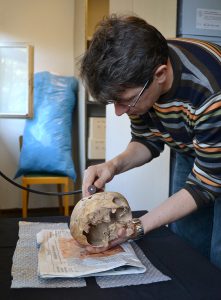Dating human remains potentially subject to 14C reservoir effects
Dr. John Meadows
Human bone is often the preferred 14C sample material, for compelling archaeological reasons, but it can give misleadingly old 14C ages because of dietary reservoir effects (caused by fish consumption, as carbon in freshwater or marine ecosystems is often depleted in 14C relative to terrestrial sources). Stable isotope data from human remains and potential food species can be used to estimate the carbon contributions of different food sources to different fractions of the human remains (e.g. bulk collagen and bio-apatite),

and if the extent of 14C-depletion in aquatic food sources can be quantified, it is in theory possible to calculate realistic corrections to 14C-ages. This issue is particularly pertinent in research on later prehistoric foragers in northern Eurasia, as these societies often relied heavily on freshwater food sources, and 14C depletion can be both extreme and highly variable in freshwater ecosystems; moreover, their absolute chronologies are often poorly understood (being based in part on 14C ages of food crusts on pottery: see „Fishy Food Crusts“ project), and significant 14C reservoir effects in human remains may therefore not be detected.

This project is testing the usefulness of the stable isotope approach in correcting 14C ages for dietary reservoir effects, using case studies in which archaeological evidence tightly constrains the relative or absolute dates of human remains. At Zvejnieki, Latvia, we sampled 5 individuals who must have died almost simultaneously (see project „Research on the absolute chronology of cultural and topographical developments during the Stone Age in the eastern Baltic region“; Riņņukalns skull). At Olmo di Nogara, near Verona, Italy, we quantified 14C reservoir effects in 17 individuals, using a chronological model which incorporates their 14C ages and stratigraphic relationships, the changing typology of grave goods, and the 14C ages of samples which are not subject to reservoir effects. Stable isotope analyses of fauna from both settings are under way. The goal of this project is to improve the chronologies of burials and associated grave goods in the circum-Baltic region by recognizing and minimizing the uncertainties in human 14C ages due to dietary reservoir effects.
Research clusters
Man and Environment
Research Priorities
Fundamental research in scientific archaeology
Staff
Chiefs:
Dr. John Meadows
In cooperation with
Ricardo Fernandes (Institute for Ecosystem Research/Leibniz-Labor, CAU-Kiel/McDonald Institute for Archaeological Research, University of Cambridge)
Ilga Zagorska, Valdis Bērziņš, Gunita Zariņa, Institute of Latvian History, University of Latvia
E Valzolgher, Archäologische Untersuchungen O.H.G., Brixen, Italy
L. Salzani, Soprintendenza dei Beni Culturali, Verona, Italy